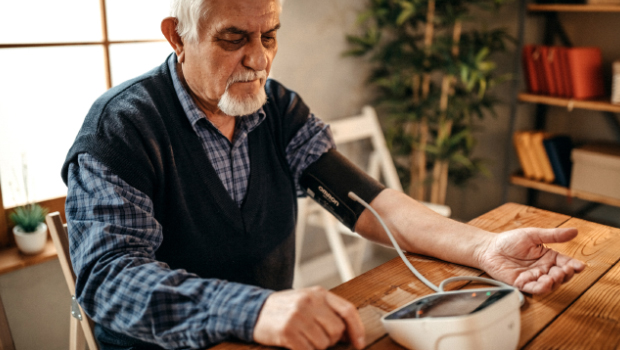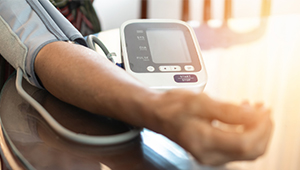There’s no place like home … to track blood pressure

Research led by KPWHRI’s Beverly Green finds that patients prefer at-home monitoring of blood pressure
Adults who needed to track their blood pressure regularly to confirm or refute a hypertension diagnosis preferred monitoring blood pressure at home versus at a clinic, kiosk, or with a 24-hour wearable device, according to new research presented at the American Heart Association’s Hypertension 2021 conference, the premier scientific meeting focusing on recent advances in basic and clinical research on high blood pressure.
According to the American Heart Association, about 1 in every 2 U.S. adults has high blood pressure, or hypertension. More than 1 in 3 adults might not know they have it. High blood pressure is defined as having a systolic pressure (the top number in a reading) of 130 or higher, or a diastolic pressure (the bottom number) of 80 or higher.
“Most hypertension is diagnosed and treated based on blood pressure measurements taken in a doctor’s office, even though the U.S. Preventive Services Task Force and the American Heart Association recommend that blood pressure measurements be taken outside of the clinical setting to confirm the diagnosis before starting treatment,” said lead study author Beverly Green, MD, MPH, senior investigator at Kaiser Permanente Washington Health Research Institute and family physician at Kaiser Permanente Washington in Seattle. “It is the standard that blood pressure monitoring should be done either using home blood pressure monitoring or 24-hour ambulatory blood pressure monitoring prior to diagnosing hypertension.”
Twenty-four-hour ambulatory blood pressure monitoring devices, worn day and night to take continuous blood pressure readings, are generally considered the “gold standard” for out-of-office measurement to determine a diagnosis of high blood pressure. However, blood pressure measured on a home device, with a traditional blood pressure arm cuff, can be a more practical and convenient approach.
Green and colleagues studied adherence to and acceptability of different blood pressure measuring methods among 510 adults who had elevated blood pressure yet had not been diagnosed with high blood pressure. They were participants in the Blood Pressure Checks for Diagnosing Hypertension (BP-CHECK) trial. Participants in the study were an average age of 59 years old; 75% were non-Hispanic white, 7% African American, 6% Asian, 5% Hispanic white, and 7% other; half were male; and the average blood pressure was 150/88. They were not on blood pressure-lowering medications.
Participants were randomly assigned to 1 of 3 groups for determining a new diagnosis of hypertension: clinic measurements, home monitoring, or kiosk blood pressure monitoring.
Those in the group for clinic measurements were asked to return to the clinic for at least one additional blood pressure check, as is routine in diagnosing hypertension in clinical practice. The home group received home blood pressure machines, were trained to use them, and were asked to take their blood pressure twice a day with 2 measurements each time, for 5 days, for a total of 20 measurements. The kiosk group was asked to take their blood pressure at a kiosk in their clinic or at a nearby pharmacy on 3 separate days, with 3 measurements each time, for a total of 9 measurements. All participants were asked to complete their group-assigned diagnostic regimens within 3 weeks, and then to complete 24-hour ambulatory blood pressure monitoring.
Researchers measured adherence to monitoring by noting the percent of individuals in each group who completed their assigned measurement method as instructed. They measured acceptability with questionnaires.
They found:
- Overall acceptability was highest for the at-home group, followed by the clinic and kiosk groups. Twenty-four-hour ambulatory blood pressure monitoring was the least acceptable option.
- Participants were least likely to adhere to the monitoring regimen in the kiosk group. Adherence was more than 90% among those in the home-testing group, more than 87% in the clinic group, nearly 68% in the kiosk group, and 91% for 24-hour ambulatory monitoring among all participants.
“Home blood pressure monitoring was the most preferred option, as it was convenient, easy to do, did not disturb their daily routine or work as much, and was perceived as accurate,” Green said. “Participants reported that ambulatory blood pressure monitoring disturbed daily and work activities, disrupted sleep, and was uncomfortable.”
When asked which diagnostic testing regimen they would prefer, more than half chose home blood pressure monitoring, especially if they were assigned to the home group, where almost 80% preferred home monitoring.
Green suggests health care professionals routinely offer home blood pressure monitoring to their patients with elevated blood pressure. This might involve providing home blood pressure monitors, training patients, and collecting and averaging several days of blood pressure readings.
“Health care professionals should work toward relying less on in-clinic visits to diagnose hypertension and supporting their patients in taking their blood pressure measurements at home,” Green said. “Home blood pressure monitoring is empowering and improves our ability to identify and treat hypertension, and to prevent strokes, heart attacks, heart failure, and cardiovascular death.”
A study limitation is that participants were mainly white, which is not representative of all people who have high blood pressure. According to American Heart Association statistics, about 50% of white and Hispanic men and 40% of white and Hispanic women have high blood pressure, while 58% of Black men and women have it.
Co-authors are Melissa Anderson, MS; Jennifer McClure, PhD; Matthew Thompson, MBChB, MPH, DPhil; Kelly Ehrlich, MS; Yoshio Hall, MD, MS; Karen L Margolis, MD, MPH; and Dwayne Joseph.
The study was funded by the Patient Centered Outcomes Research Institute (PCORI).
Co-researchers
Melissa L. Anderson, MS
Principal Collaborative Biostatistician
Kaiser Permanente Washington Health Research Institute
,
RESEARCH

New research identifies flaws in hypertension diagnoses
KPWHRI investigator’s recent AHA presentations highlight problems in blood pressure readings.
News

Diagnosing high blood pressure: Who knew it could be so complicated?
High blood pressure is a well-known health risk. But diagnosing it can be challenging. With patient advisors, the BP-CHECK study aims to find an easier way.
Healthy findings blog

How a physician-scientist studying blood pressure became a patient too
Dr. Beverly Green, PCORI-funded BP-CHECK leader, reflects on her professional interest in hypertension getting up close and personal.



